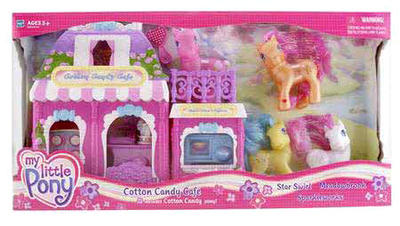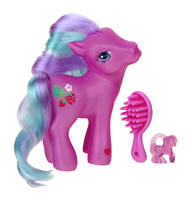Hasbro "COTTON CANDY" Pony Finishes Out of the Running in TTAB Cancellation Clash
Like the proverbial rented mule, Hasbro, Inc. took a beating in its Section 2(d) opposition to registration of the mark COTTON CANDY CLOUD CASTLE for dolls, dollhouses, and other toys. Hasbro relied on its registration of and common law rights in the mark COTTON CANDY for a "toy pony," but Applicant Mitchell W. Goldman successfully counterclaimed for cancellation of Hasbro's registration on the ground of abandonment. Hasbro, Inc. v. Goldman, Opposition No. 91156238 (August 29, 2005) [not citable].

Hasbro stumbled out of the gate when it failed to submit a status-and-title copy of its COTTON CANDY registration or otherwise prove ownership. However, Goldman's counterclaim for cancellation made the registration of record in the proceeding as a whole. See Rule 1.133(b)(1).
Hasbro's testimony showed that it began using the COTTON CANDY mark in 1982 in conjunction with its "My Little Pony" line of products. However, sales were discontinued during the period 1992-1996, during which time Hasbro "decided to 'rest' the My Little Pony line of products." During 1996-1999, Hasbro re-launched the line, but not including the COTTON CANDY mark. In 2003, Hasbro started up again, and included a "toy pony" under the COTTON CANDY mark. The Board noted Hasbro's testimony that My Little Pony television specials and a movie were made in the 1980s, and a video was sold in 1991 featuring COTTON CANDY, but the evidence was limited and unclear. At most, COTTON CANDY was used as a character name, and not as a mark for a product, "and certainly not as a mark for 'toy ponies' in International Class 28."
Priority: Hasbro strayed way off course in asserting that, even if its registration were cancelled, it would have priority over Goldman because it reintroduced the mark in 2002 and therefore is the "senior user" since ITU applicant Goldman had yet to use the mark. The Board quickly reined in that argument, pointing out the fundamental rule that in an opposition, an ITU applicant is entitled to rely on its filing date as a constructive first use date. See Zirco Corp. v. American Tel. and Tel. Co. 21 USPQ2d 1542 (TTAB 1991).
Abandonment: There was no real dispute that Hasbro discontinued use of the COTTON CANDY mark for three consecutive years prior to Goldman's filing date of February 7, 2001. Under section 45, nonuse of a mark for a three year period constitutes prima facie evidence of abandonment. This shifted to Hasbro the burden to produce evidence showing that it intended to resume use.

Hasbro's testimony that it had an intent to resume use during "the break in use from 1987 through 2002" was accorded little weight (since "[i]n every contested abandonment case, the respondent denies an intention to abandon its mark; otherwise there would be no contest.") Hasbro emphasized:
"(1) that it 'recycled' the various My Little Pony characters; (2) that Hasbro considered the My Little Pony line, including its original characters, such as COTTON CANDY, a 'core brand' for the company; (3) that Hasbro 're-released' the 1991 video 'featuring' the original toy ponies, including COTTON CANDY; and (4) that an avid collector's market existed for the sale of the original toy ponies including COTTON CANDY in the years following 1987."
The Board was not carried away by Hasbro's assertions. It noted that nothing in Hasbro's testimony about recycling or its "core brand" referred to its intentions regarding the COTTON CANDY toy pony. The evidence as to the 1991 video was sparse and at most indicated possible use of COTTON CANDY as a character name in the video. As to the collector's market, Hasbro's evidence concerned a period after 2003, and in any case was "no way probative of what Hasbro's intentions were with regard to any future use of COTTON CANDY on toy ponies from 1987 to 2002."
The Board concluded that Hasbro had abandoned the COTTON CANDY mark as of the filing date of the Goldman application.
Fraud: Goldman also claimed that Hasbro committed fraud when it filed its combined Section 8 and 15 declaration for the COTTON CANDY registration in September of 1989 [the Board erroneously refers to this as a combined Section 8 and 9 declaration], first because it averred that the mark had been in use for five consecutive years. However, the person who signed the combined declaration did not testify, and there was testimony that COTTON CANDY was used in the late 1980s as a "cutie mark" on another toy pony known primarily by another name. Thus the Board found the evidence too ambiguous to permit a finding of fraud.
Goldman also claimed fraud because the combined declaration stated that the mark was in current use, but the specimen did not show "current" use. The Board, however (apparently unwilling to saddle Hasbro with a fraud charge), pointed out that the acceptability of a specimen is not a separate ground for cancellation, and it declined to find fraud on that basis.
Text Copyright John L. Welch 2005.




0 Comments:
Post a Comment
<< Home